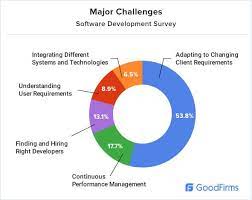Exploring the Journey of Junior Software Developers in the Tech Industry
The Role of Junior Software Developers in the Tech Industry
In the fast-paced world of technology, junior software developers play a crucial role in shaping the future of software development. These entry-level professionals bring fresh perspectives, enthusiasm, and a willingness to learn to their teams.
Learning and Growth
Junior software developers are often recent graduates or individuals transitioning into a new career. They have a strong foundation in programming languages and concepts but lack practical experience. Working alongside senior developers, they have the opportunity to learn new skills, best practices, and industry standards.
Collaboration and Innovation
Junior software developers collaborate with team members to design, develop, and test software applications. Their input is valuable in brainstorming sessions and problem-solving activities. By contributing ideas and exploring creative solutions, junior developers help drive innovation within their teams.
Mentorship and Support
Senior developers act as mentors to junior team members, providing guidance, feedback, and support. Through mentorship programs and on-the-job training, junior software developers receive personalized attention that accelerates their professional growth.
Adaptability and Resilience
Junior software developers must be adaptable and resilient in the face of challenges. They learn to navigate complex projects, meet deadlines, and troubleshoot issues effectively. By embracing change and staying proactive, junior developers demonstrate their readiness to tackle any task that comes their way.
Career Advancement
As junior software developers gain experience and expand their skill set, they become eligible for more advanced roles within the tech industry. With dedication, hard work, and continuous learning, junior professionals can progress to positions such as senior developer, technical lead, or project manager.
In Conclusion
Junior software developers are integral members of tech teams who contribute fresh ideas, energy, and a passion for learning. Their role is essential in driving innovation, fostering collaboration, and ensuring the success of software projects. As they grow in experience and expertise, junior developers pave the way for a bright future in the ever-evolving world of technology.
Understanding the Role and Demand for Junior Software Engineers: FAQs Answered
- Are junior software engineers in demand?
- Is junior better than senior?
- What is the role of a junior software developer?
- Is junior above entry-level?
- What is junior software?
- What is a junior in software development?
- What level is junior software engineer?
- What is a junior software?
Are junior software engineers in demand?
In today’s tech-driven world, the demand for junior software engineers is on the rise. As companies continue to invest in digital transformation and software development projects, there is a growing need for entry-level professionals to support these initiatives. Junior software engineers bring fresh perspectives, enthusiasm, and a willingness to learn to their teams, making them valuable assets in the ever-evolving tech industry. With a strong foundation in programming languages and concepts, junior developers have opportunities for growth and advancement as they gain practical experience and expand their skill set. Overall, the demand for junior software engineers reflects the industry’s recognition of their importance in driving innovation and success in software development projects.
Is junior better than senior?
In the realm of software development, the comparison between junior and senior roles is not about one being inherently better than the other, but rather about different levels of experience and expertise. Junior developers bring fresh perspectives, enthusiasm, and a willingness to learn, while senior developers possess years of experience, in-depth knowledge, and leadership skills. Both junior and senior developers play vital roles in a team, with juniors contributing innovative ideas and eagerness to grow, and seniors providing mentorship, guidance, and expertise. Each level has its unique strengths and value, making them equally important in creating successful software projects.
What is the role of a junior software developer?
The role of a junior software developer is to support the development team in designing, coding, testing, and maintaining software applications. Junior developers work under the guidance of senior team members to learn best practices, enhance their technical skills, and contribute to projects. They collaborate with colleagues to solve problems, implement solutions, and ensure the quality and functionality of the software. Junior software developers play a vital role in the software development lifecycle by bringing fresh perspectives, enthusiasm, and a willingness to learn to their teams while gaining valuable experience that prepares them for more advanced roles in the tech industry.
Is junior above entry-level?
In the realm of software development, the distinction between “junior” and “entry-level” roles can vary depending on the company and industry standards. Generally, a junior software developer is considered to be slightly above entry-level in terms of experience and skill level. While entry-level positions typically target candidates with minimal to no professional experience in the field, junior roles often require some foundational knowledge or practical exposure to software development concepts. Junior developers are expected to have a basic understanding of programming languages and tools, making them more prepared to take on tasks that may require a bit more expertise than what is typically expected from entry-level positions.
What is junior software?
Junior software refers to entry-level professionals in the field of software development who are typically recent graduates or individuals new to the industry. These junior developers possess foundational knowledge of programming languages and concepts but lack extensive practical experience. They play a vital role within tech teams by contributing fresh perspectives, enthusiasm, and a willingness to learn. Junior software developers work closely with senior team members to enhance their skills, collaborate on projects, and gain valuable hands-on experience that propels their growth in the industry.
What is a junior in software development?
In the realm of software development, a junior refers to an entry-level professional who is in the early stages of their career within the field. Junior software developers typically possess foundational knowledge of programming languages and concepts but have limited practical experience in real-world projects. They often work under the guidance of more experienced developers, learning from their expertise and gaining hands-on experience in coding, testing, and debugging software applications. Juniors play a vital role in tech teams by contributing fresh perspectives, enthusiasm, and a willingness to learn as they grow and develop their skills in the dynamic landscape of software development.
What level is junior software engineer?
In the tech industry, the level of a junior software engineer is typically considered to be an entry-level position. Junior software engineers are recent graduates or individuals with limited professional experience in software development. They work under the guidance of senior developers and team leads, gaining hands-on experience, learning best practices, and contributing to projects while honing their skills. Junior software engineers are essential members of development teams, playing a crucial role in building their expertise and advancing their careers within the tech industry.
What is a junior software?
A junior software developer is an entry-level professional in the field of software development who typically has a foundational understanding of programming languages and concepts but lacks extensive practical experience. Junior software developers often work under the guidance of more experienced team members, such as senior developers, to learn new skills, best practices, and industry standards. They play a vital role in contributing fresh perspectives, enthusiasm, and a willingness to learn to their teams, ultimately helping drive innovation and growth in the tech industry.






